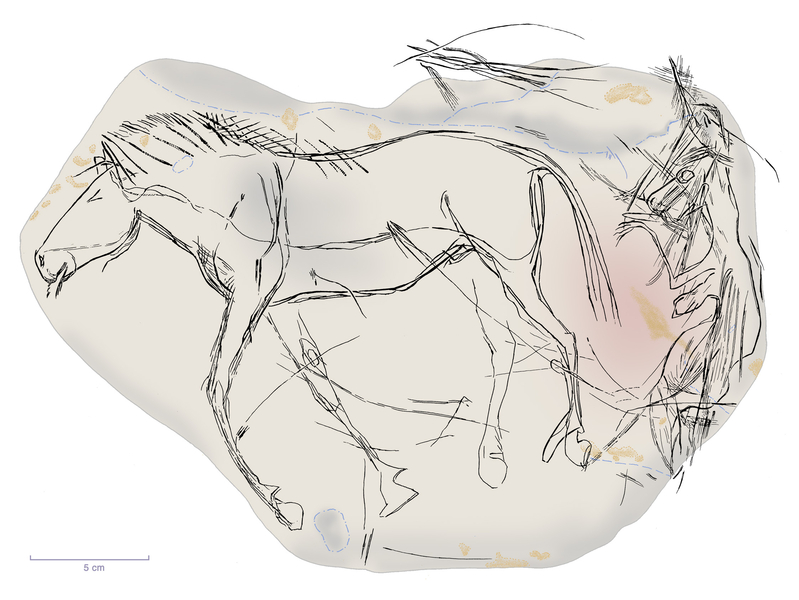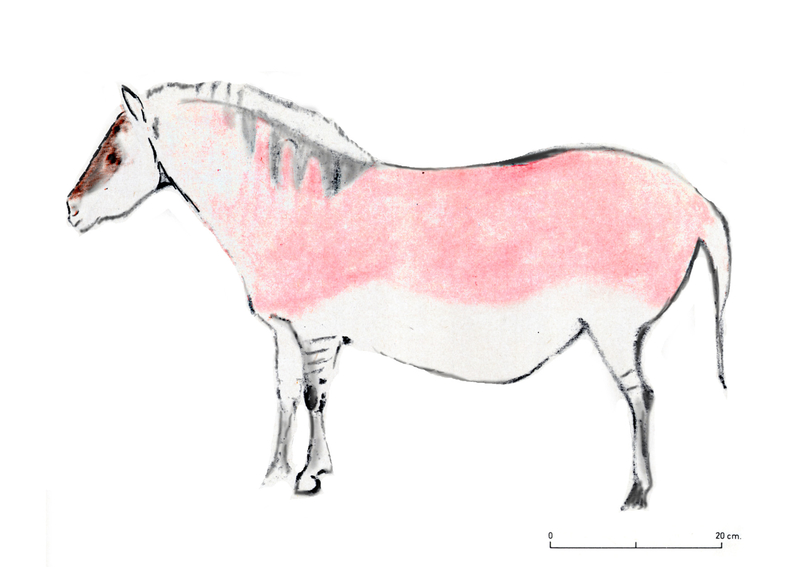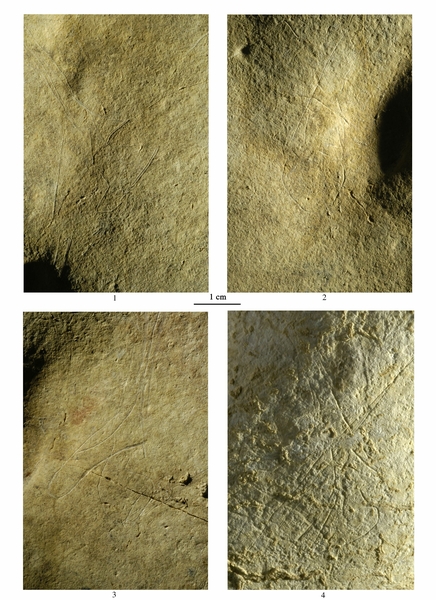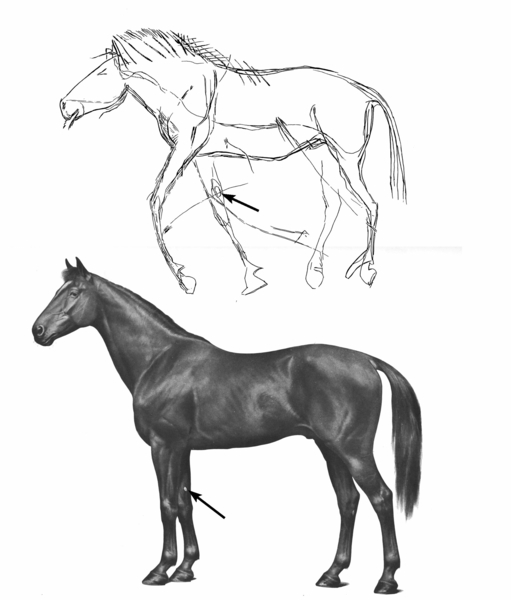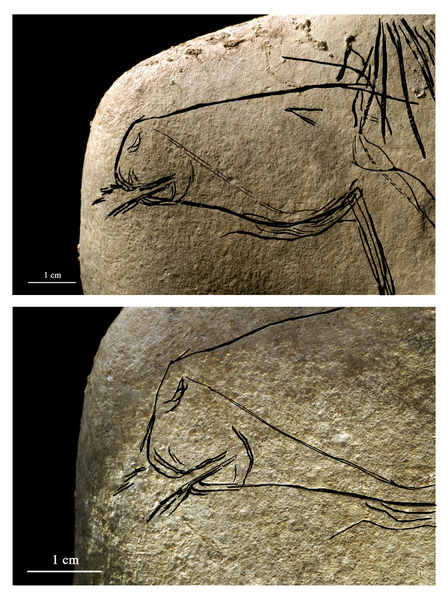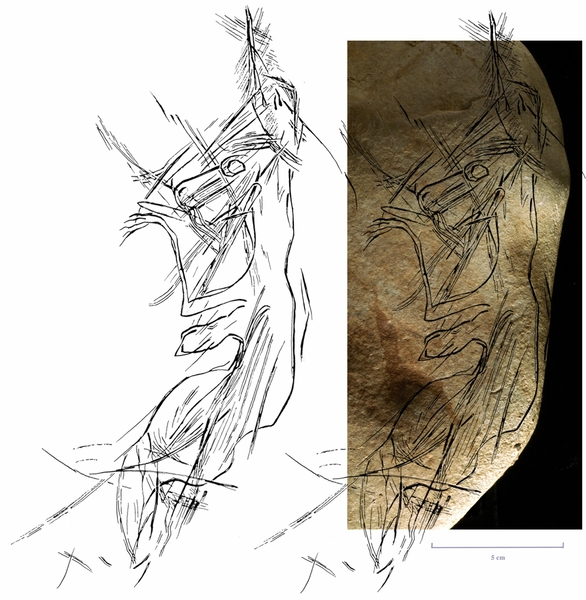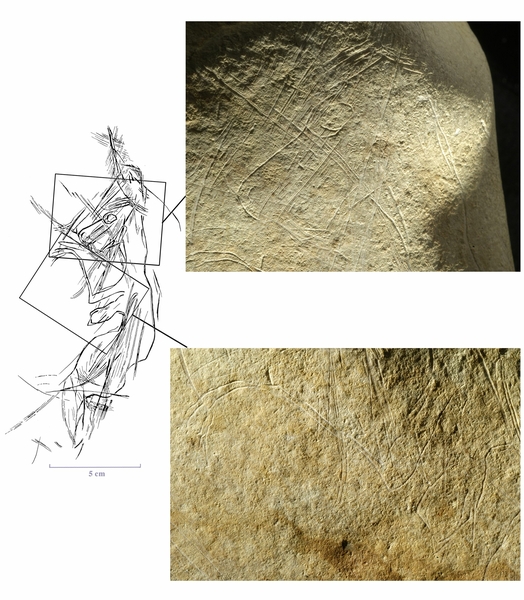- Home
- The engraved pebble from Étiolles
- A major discovery
- Exceptional artistic evidence
- The front
The front is covered with fine engravings, which could only be deciphered following very careful observation.
Covering the majority of the surface, the left profile of a horse can be made out. At the groin, a discreet sheath identifies it is a stallion, depicted as if he is lying on his flank, with eye closed, mouth open and limbs inert, dying. Above the horse, a firmly engraved pattern on the edge evokes an arrow.
The horse
Shown from the left side, the horse has four long, slender limbs, drawn in perspective. The limbs on the right side of its body disappear just before the body, thus signalling the plane furthest from the viewer. With the exception of the resting front right leg, these floating limbs appear fainter than the rest of the horse. The neck, which is short and strong, supports a resting head and a bristling mane, engraved in three stages. The ear can just be distinguished from the mane. The line of the back is not aligned with the first version of the mane, therefore it is likely that the engraver began by creating the isolated head, before adding the rest of the figure.
Sinuous lines on the body, cheek and muzzle show the differences in colour in the horse’s coat. It is possible that these lines were the borders between colours, perhaps red, like in some of the Magdalenian horses that appear in wall paintings, for example at Ekain. No traces of pigment have been found, but the presence of a layer of red ochre surrounding the hearth where the pebble was discovered would support this hypothesis.
Fine curves show the shape of the shoulder, and the hocks and hooves are also very detailed, despite the enigmatic form of the front right and back left hooves. There is a protuberance on the front of the front right hoof, perhaps due to a slip or working too quickly. There is evidence of a first version of the back left hoof, pointed and not anatomically correct. It was replaced by a normal equid hoof.
On the inside of the front right leg, there is a discreetly drawn chestnut, a growth which is typical on horses. This detail, rare in Palaeolithic art, highlights the level of naturalism in this figure.
Short lines hang out from the open mouth, suggesting a tongue, unless the animal is spitting or breathing heavily. Two convergent lines form the eye, as if the eyelid was closed.
There are two signs of injuries on the horse’s flank, one extending in a curved line downwards. The same type of mark appears on the front right. Together all these details suggest that the horse was probably dying, lying on its flank, with its eye closed and mouth open.
Copy of the front.
© Carole Fritz, Gilles Tosello
1: The horse’s head with the first version of the mane.
2: The entire horse and the associated visible signs.
© Carole Fritz, Gilles Tosello
Hypothesis for the reconstruction of the horse with a red coat.
© J. Altuna
Black and red horse engraved in the Ekain cave in the Basque Country. Note the shape of the surface painted in red on the horse’s body.
© copy J. Altuna
Extremities of the legs of the horses on the pebble.
1: Front right hoof (horse on front).
2 and 3: Back left and right hooves (horse on front).
4: Front left hoof of horse engraved on back
© cl. C. Fritz
Comparison of the horse engraved on the front with an illustration of an actual equid. The arrows indicate the chestnuts (torus carpeus) visible on the front limbs.
© after Ellenberger, Baum and Dittrich, 1949
Details of the head of the horse on the front. Note the short lines which seem to come out of the horse’s mouth.
© cl. C. Fritz
The therianthrope
The right side of the pebble contains an engraving which is not immediately easy to discern. It is in fact a therianthrope, with its combination of animal and human features, and specifically, female, made apparent by the breast visible beneath the raised arm.
Standing and straight-backed like a human, the creature has a rounded occiput, a prognathic muzzle with whiskers like a carnivore and a long bifid beard. Its neck leads down to a folded arm, with a clearly-marked elbow and a hand with five fingers or claws, brandishing a line intersected by what looks like a spindle, in front of the muzzle. Above the head there are many unclear lines about which we have been unable to draw any conclusions. Some suggest some sort of headwear.
The rest of the body is that of a female, with a hanging breast and swollen belly. The lower limb is barely illustrated.
Close-up view of the therianthrope engraved behind the horse.
© doc. C. Fritz – G. Tosello
Detail of the therianthrope’s head, arm and breast.
© doc. C. Fritz – G. Tosello

